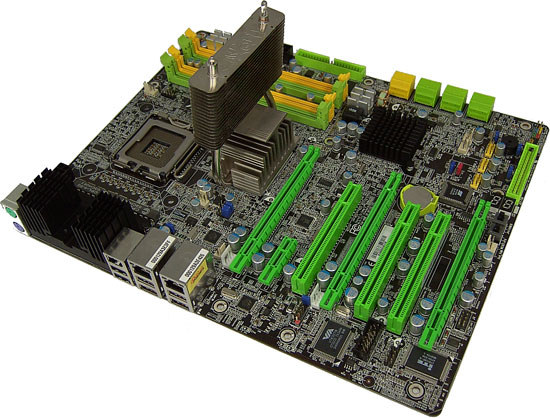DFI X48 LT T2R: Floats like a Butterfly…
by Rajinder Gill on April 28, 2008 4:00 AM EST- Posted in
- Motherboards
After a very successful DFI P35 T2R motherboard launch, DFI endeavored to apply the same level of engineering expertise to Intel's X38/X48 chipsets. We did not review the DFI X38 motherboard, but instead decided to look at the X48-based motherboard from DFI in DDR2 form. Finally, after a slew of delays, Intel's X48 chipset is available in large enough quantities to manufacturers to allow full retail rollout. Intel delivered the initial batches of X48 chipsets to preferred launch partners such as ASUS and Gigabyte who were first to market, but now we are seeing this chipset in boards from other suppliers.
Expectations placed on the LANParty series from DFI are always high, but it has become more difficult for companies like DFI to stay ahead of the pack as boards from ASUS's ROG line have also begun to employ many of the additional BIOS functions that provided DFI with elite status among overclocking circles in the past. Although some of the competitors are now within a whisker of DFI's approach to BIOS options, a slight gap still remains in ultra fine voltage and memory clock skew control ranges; these allow users to dial in the last few MHz of stability while using lower levels of memory and chipset voltages (with some perseverance).
While this level of control to return ratio may not interest most users, DFI still enjoys a loyal following of people who regard tuning a DFI BIOS as a hobby and notable pastime. This does not mean that DFI's current boards only favor users who have vast levels of BIOS tuning experience or masses of time. In fact, DFI has improved the auto default settings of their boards considerably over the past year. So much so, that it is now no longer necessary to hold a masters degree in BIOS manipulation just to get the boards to boot and work in a stable manner. Online communities serve to provide additional information for those who are just starting out and want to learn more about the finer tweaking options that DFI provides.
In spite of DFI making these stock setting 'ease of use' advancements, we still have to concede that users of a 'tweaking' oriented mindset will lean towards this kind of motherboard. If instead you subscribe to the belief that all boards are the same, or if fine tweaking options do nothing to float your boat, there's a whole host of sub-$200 motherboards based on Intel's P35 chipset that fill the role of a good overclocking board perfectly. Boards priced above $200 must fight fiercely not only to provide masses of BIOS options and functionality, but also justification for their price tag against a competitively priced product. Ultimately, the boards are often so closely matched that winners emerge based upon the ease at which a user can attain high FSB speeds that can be run in a stable manner. The question is: can DFI topple ASUS's X38/X48 DDR2-based boards such as the Maximus Formula and superlative Rampage Formula?
 |
Interested to learn as much as we could about this X48-based offering, we spoke with DFI recently about their latest foray with Intel's chipsets. We were surprised to learn that Intel did not provide much support to DFI when it came to revealing the nature and use of performance related chipset registers that are available for manipulation via BIOS coding. So here, we have Intel claiming to be overclocking friendly on one hand and yet failing to provide full support to a key enthusiast manufacturer on the other. We are told this situation is set to improve - and rightly so. With rapid changes in processor architecture, B-tier manufacturers need all the support they can get to reduce development time and cut research costs in order to provide a competitive product in the market.
With release of Intel's P45 looming, DDR2-based X48 boards have their work cut out, especially if the P45 improves in areas such as low voltage requirements, reduced thermals, and tRD performance along with FSB overclocking headroom. If these conditions are met, a trump card of dual 16x PCIE slots on the X38/X48 chipsets may not hold enough allure to prevent users from looking at the P45, which can be simply teamed with any single slot dual-GPU solution to provide similar performance.
Reader feedback regarding our extensive BIOS guide on the DFI P35 UT T2R was very positive and we are back with a similar level of information today. Luckily, for us, the BIOS on the X48 board we are reviewing today bears many functional and naming similarities to the DFI P35 board - only the ranges really need changing, together with some additional work on the VTT/GTL reference voltage tables to get the most from it.
In keeping with our quest for continual improvement, we will present our first video BIOS setup guide that can be viewed easily if your computer has the latest version of Adobe's Flash Player loaded. We really feel that this will help users who have never used a DFI BIOS to obtain a reference point for setup when overclocking the latest dual-core CPUs from Intel. We will provide quad-core results shortly and look forward to your comments and suggestions with the new format. In the meantime, let's look at the DFI X48 LT T2R and see what this board offers for the enthusiast.










24 Comments
View All Comments
lopri - Monday, April 28, 2008 - link
Sorry if I missed it but I can't locate it?Rajinder Gill - Monday, April 28, 2008 - link
Hi,There is no PDF, it is an Adobe flash player video on page 14..
regards
Raja
Kromis - Monday, April 28, 2008 - link
I'm loving the green!Kromis - Monday, April 28, 2008 - link
I haven't heard/read much from DFI in a while